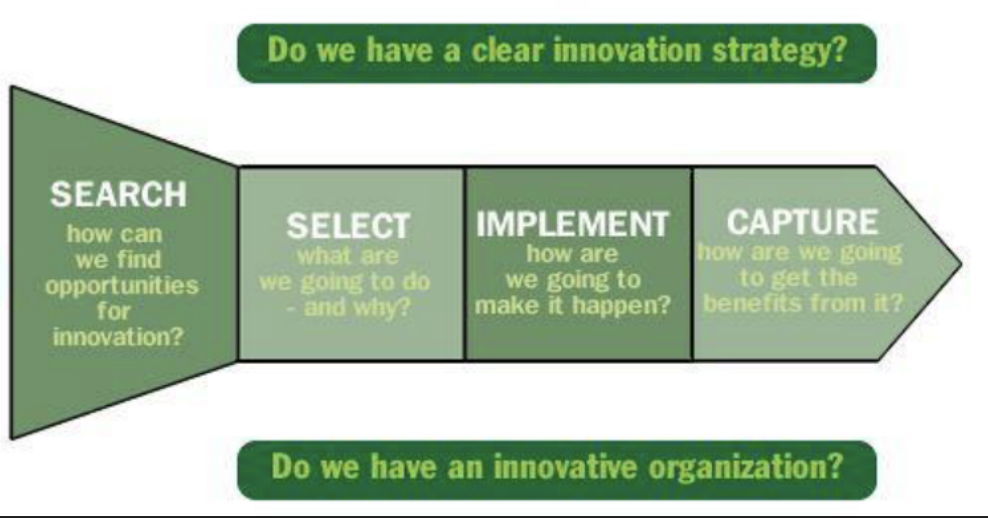How collaboration platforms can help turbocharge your innovation efforts

GUEST POST from John Bessant
Say the word ‘innovation’ and many people quickly conjure in their mind the wonderful ‘lightbulb moment’. But of course, innovation isn’t like this — that flash of inspiration is only the start of what will be a long journey trying to create value from that initial idea. It’s all about navigating our way through a landscape of uncertainty, learning to deal with a variety of roadblocks, potholes and other unexpected barriers.
And if we want to be able to repeat the trick, to give our ideas a fighting chance then the evidence is clear; we need some kind of a process. Over a hundred years of research has fed our understanding to the point where the kind of system we need to make innovation happen can be specified as an international standard. And in terms of pictures what we’re really looking for is less a lightbulb moment than a reproduceable process, something like this.

Which is fine, as long as we bear in mind one important truth. Innovation doesn’t happen like that.
Back in 1931 the mathematician Alfred Korzybski presented a paper to a meeting in New Orleans on mathematical semantics. It was pretty complex stuff but one phrase which he used has stuck in the wider popular memory. He pointed out that ‘the map is not the territory…’ In other words, a description of something is not the thing itself. The model is not reality. Which has some pretty important implications for the way we work with innovation.
Process models, however detailed, are simplifications, ways of representing how innovation might take place. But — like any map, be it a crumpled sketch someone has drawn or a sophisticated Google Maps picture — it is a guide, it isn’t the place itself. The map is, by its nature, a reduction of the process and in reducing it we lose some important information.
The reality, of course, is that innovation is more complex. And it’s all about knowledge spaghetti.
Just like a plate of pasta innovation involves many different strands. Only this time we are talking about knowledge — technical knowledge, market knowledge, legal knowledge, financial knowledge and so on. They need to be woven together to create value.
And these knowledge strands are held by different people, inside and outside the organization. We have to find them and connect them, link them together to enable us to innovate. Whilst we can superimpose structures on it to help us with this task, we shouldn’t forget that we’re really working with knowledge spaghetti.
Spaghetti solutions
So how do we work with it? Just like recipes for spaghetti there are many variations. One approach is to employ specialists and create cross-functional teams which bring together the relevant strands and align them towards a focused target. That’s proved to be a good model for developing new products and services, especially if we can find ways to bring in all the relevant players including users.
We can use a similar cross-functional approach to the design and implementation of major internal process innovations — things like introducing a new IT system or reorganizing to become more customer-focused. And a third approach involves carefully constructed strategic collaborations, bringing knowledge partners together with complementary strands of knowledge spaghetti.
One very powerful model is based on the idea that everyone in the organization has something to contribute to the innovation story — high involvement innovation. Here we’re working on the belief that even small strands of knowledge can be important and if we could bring them in to the story, we’d make significant progress.
Which history tells us we can. In countless embodiments the principle of high involvement has been shown to pay dividends. Ask people for what they know that might help solve problems around quality, cost, delivery, etc — and there’s no shortage of good ideas in response. The challenge has, historically, been one of working with such high volumes of knowledge and keeping the flywheel going by responding to employee suggestions and giving feedback on progress towards their implementation.
 Suggestion boxes and schemes work but until recently had their limitations. Two recent trends have changed all that. The first, borne on the waves of total quality thinking and then the whole ‘lean’ movement, has shown us that in any context people are very effective innovators, well able to improve on what they are doing on a continuing basis.
Suggestion boxes and schemes work but until recently had their limitations. Two recent trends have changed all that. The first, borne on the waves of total quality thinking and then the whole ‘lean’ movement, has shown us that in any context people are very effective innovators, well able to improve on what they are doing on a continuing basis.
And the second has been the emergence of collaboration platforms on which they can deploy their innovation skills. Today’s collaborative innovation platform resembles its suggestion box predecessor in outline only; it’s still a way of collecting ideas from employees. But it does so in an interactive space in which challenges can be posed, ideas suggested, comments added and shaping, and welding together multiple knowledge sets and experience enabled. And in doing so they open up the very real possibilities of high involvement innovation — getting everyone to contribute to the innovation story.
Emergent properties
But it’s not just the raw return on investment which collaboration platforms offer — though these benefits are impressive. Their real value lies in the way they enable ‘emergent properties’ — the innovation whole becomes much greater than the sum of its parts.
They give us new and powerful ways of working with the knowledge spaghetti. Not only can we handle the sheer scale of the knowledge challenge and focus it towards key objectives but we can do so in ways which yield surprising additional benefits. They effectively turbocharge our innovation system.
In particular they contribute in the following ways:
High involvement innovation has always worked well in teams — that’s been at the heart of the success of lean approaches. But until recently that depended on the team being physically together, exploring and co-creating solutions — not easy if you’re working with a distributed team. Platforms solve this challenge, enabling virtual team meetings and collaboration and asynchronous collaboration.
Organizations like Conoco-Philips employ around 10,000 people, globally distributed and often in hard to access places like off-shore oil platforms. Airbus has around 130,000, again globally distributed and engaged in multiple activities. And Bombardier have over 15,000 ‘knowledge workers’ around the world with whom they want to engage. Through the use of collaboration platforms organizations like these are able to achieve sustained high involvement and significant traction on their innovation challenges.
- Richness — successful high involvement innovation isn’t just about assembling lots of people. By their nature people are different and diversity matters in innovation. They bring different perspectives, different ways of framing and working with the problem being explored. Plus they are not just cardboard cut-outs, they have a rich history of different experiences — their origins, their education, their work experience. All of this represents potentially useful strands of knowledge spaghetti, and platforms help us draw on this.
Subsea7, a major player in the world of offshore services for the oil and other industries has used a platform approach to great effect. In one example a long-running concern with turnaround times for fitting out ships was solved when someone on the platform identified a solution which he had originally seen in action at a previous employer. The resulting savings ran into millions of dollars.
People also bring with them networks of connections; knowledge is socially distributed and connecting to these networks can yield surprising possibilities. It means the innovating organization can access different skills and specialized knowledge inside and outside the organization. It’s classic open innovation, building on the idea that in even the largest organization ‘not all the smart people work for you’.
- Refining — one of the powerful features of collaboration platforms is that they enable — well, collaboration! They make it possible to comment, criticize (constructively), modify and refine ideas, setting up a process of true co-creation. This fits well with recent research which argues that there’s a fundamental flaw in the model of ‘brainstorming’ used by many organizations to source ideas. The principle of postponing judgment has been replaced by a ‘no criticism’ approach in which every idea is accepted. But the reality is that good ideas need to be tempered, hammered into shape, worked on — and processes of constructive criticism are really important. Pixar, for example, has made this a core feature of its daily ideation process.
And having access to the diversity of perspectives which platforms allow means that there is real potential for shaping and developing interesting ideas into great and value-adding ones. They provide a way of creating those magical ‘water-cooler’ moments in an online and distributed world.
- Requiring — using focused campaigns to draw out ideas in particular directions. One of the limits of the old model of suggestion schemes is that they operate in ‘bottom up’ fashion, solving problems which are important and visible at a local level. But the real power of HII lies in mobilizing it to work on ‘top-down’ strategic challenges. The campaign model sits at the heart of many collaboration platforms and allows short intense ‘sprints’ focusing the innovation energy on a key problem area, rather like a laser beam.
Conoco Philips Alaska have been using a process targeted at continuous improvement of their extensive operations; they run between 6 and 8 campaigns every year, involve around 1500 employees and generate savings running into millions of dollars annually.
But it depends on several things — not least spending time to ensure the ‘right’ question is being asked. Simply setting ‘how can we improve productivity’ as a target is too vague, a bit like using that medieval weapon, the blunderbuss. Chances are some of your shots will hit the target but there’s an awful lot of waste involved.
So it’s important to ensure we’re asking the ‘right’ question; a key feature of successful collaboration platforms is the amount of effort which goes in to this kind of front-end problem exploration. The sharper the question the better the quality of answers and the chance that new creative pathways can be opened up.
- Recombination — ‘ if only our organization knew what it knows’ is a source of concern for anyone concerned with innovation. So much knowledge which might be useful is locked up inside silos and not shared. Worse, we don’t always know what’s inside those silos or whether and how it could be relevant to someone else. Platforms have the power to make this visible, not least by drawing it out in response to focused and challenging campaigns.
There’s also the possibility that someone else in the organization may have experienced a similar type of problem even if they don’t recognize the relevance of their experience. A powerful principle in creativity is looking for analogous solutions — for example, the challenge of cutting turnaround times in airports for low-cost carriers was solved by applying principles originally developed for Formula 1 pitstops. And the same approach was then adopted by surgeons in London looking to improve the utilization of operating theatres.
- Reverse reinvention — lots of effort is often wasted by reinventing wheels, solving the same problem in different places. Platforms offer a way of reversing this process, highlighting solutions which have been tried elsewhere and also inviting creative improvisation around those solutions, extending their applicability and effectiveness. A kind of creative re-iteration.
The Canadian engineering company Bombardier have been using a collaboration platform approach for over ten years and one of the biggest benefits they have seen is a significant increase in the amount of knowledge being shared across their organization.
- Retaining and recording — making sure ideas are retained even if they can’t be applied right now. One of the challenges of mobilizing collective intelligence is that we may well attract thousands of ideas. Some can be shaped and refined for immediate implementation, some require further work and investment. And for some there is the problem of being the right idea at the wrong time. In the past organizations hitting this problem would probably lose sight of the idea, leaving it buried in a file somewhere or gathering dust. But platforms allow for effective curation of ideas, not only tracking and recording all suggestions but also retaining them to match against future campaigns and challenges.
- Rewiring — organizations are like people — they have ‘predictive minds’ . They are inclined to take a lazy approach, picking tried and tested solutions off the shelf when they confront a problem. But being forced to redefine, to reframe, can trigger a search for new approaches to those old problems. We see this effect often under crisis conditions where traditional solution pathways may not be available and we have to think differently — to make new neural connections across the collective mind. Creating novel campaigns to provide this challenge can open up new idea space — they can help us ‘get out of the box’.
- Refreshing — at heart high involvement innovation is about people and the key ingredient to its long term success is finding ways to keep the motivation high. People are brilliant problem solvers but they’re only going to give their ideas if they see some benefit. Research has shown that money isn’t a strong motivator — but having your voice heard and having the opportunity to create the change you’d like to see around your organization is. There’s a wealth of research to support this going right back to the early years of organization studies; the message on employee engagement remains the same but the question is then raised about how to achieve this. Collaboration platforms by their inclusive and open nature offer a powerful new tool to help and organizations like Liberty Global consider this motivational aspect to be a key factor in helping build a culture of innovation across a large organization.

So whether it is an upgrade to continuous improvement activity, harvesting employee suggestions for doing what we do but better, or pushing the frontiers to create novel products and services, there’s real scope for using this turbocharged approach.
But powerful though they are, collaboration platforms are at heart still software. It’s not a case of ‘plug and play’ — getting the best out of these systems requires hands-on management, something we’ll look at in a future blog.
For more on innovation-related themes like this please visit my website
And if you’d like to listen to this as a podcast please visit my site here
Image credits: Pexels, John Bessant
![]() Sign up here to get Human-Centered Change & Innovation Weekly delivered to your inbox every week.
Sign up here to get Human-Centered Change & Innovation Weekly delivered to your inbox every week.